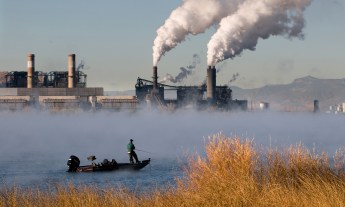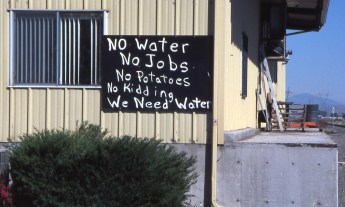
Our planet is getting hotter and drier. Drinking water is in short supply, but there are two largely untapped sources: the ocean and sewage. To get a taste of what might be in store for our faucets and understand the pros and cons, journalist Amanda Little goes to California.
The summer of 2019 has seen heat records tumble like dominoes across the Northern Hemisphere. On May 26, the thermometer climbed to 102 in Savannah, Georgia, an all-time high for that month; the same day, it hit an unprecedented 103.1 in Hokkaido, Japan’s northernmost island. Then, in June, a three-week heat wave tore through Pakistan and India, where it reached 123.4 in the central city of Churu. In July, it was Western Europe’s turn when the temperature soared to 108.7 in Paris and 102.2 in Brussels.
Of course, intense heat doesn’t occur in a vacuum. It’s accompanied by water shortages and drought, which are expected to be the new norm on our planet. In the US, drought has become associated with California. In fact, from December 20, 2011, through March 5, 2019, some form of drought existed somewhere in the state. This prolonged parching has resulted in billions of dollars in agricultural losses and the death of over 100 million trees in state forests alone.
Below, journalist Amanda Little goes to Southern California to learn more about two sources of drinking water which the state — and our planet — will be tapping in coming years.
Almost all of the water consumed by the 22 million people of California’s water-stressed southern region is imported. Much of it is pumped long distances, over mountains, from Northern California. Southern California also draws heavily from the Colorado River, the beleaguered waterway that supplies six other states and Mexico. As these freshwater sources have dwindled, the cost of water imported to Southern Californian cities has been climbing nearly 10 percent a year. The changing economics of water have forced utilities to turn in a new direction for relief: westward to the Pacific Ocean.
California has 840 miles of coastline adjoining the world’s largest ocean, an oversupply of brine lapping up against an increasingly thirsty landscape. In order to tap this massive reservoir, the San Diego Water Authority partnered with the Israeli company IDE to build a $1 billion desalination plant in Carlsbad, a suburb of San Diego. It opened in 2017, the largest desalination facility in the Western Hemisphere.
“If we could ever competitively, at a cheap rate, get freshwater from salt water, that … would really dwarf any other scientific accomplishments,” President John F. Kennedy told the Washington press corps in the 1960s.
Mark Lambert, the head of IDE’s U.S. division, who oversaw the building of the Carlsbad plant, describes desalination as “the most significant kind of modern alchemy. About 97 percent of the earth’s water is in the ocean, yet only recently have we been able to tap that resource to grow crops or quench human thirst.”
“Desalination may seem like a panacea, but from a cost and energy standpoint it’s the worst deal out there,” says Sara Aminzadeh of the California Coastkeeper Alliance.
Desalination has been around for millennia if you count the evaporation techniques pioneered by the ancient Greek. Sailors in the 4th century BC boiled salt water and then captured the steam. When cooled, steam condenses into distilled water that’s free of virtually all contaminants. This same basic technology — thermal desalination — is still used in places like Saudi Arabia, where fuel for boiling the water comes cheap. Since the 1960s, most desalination operations use reverse osmosis (RO), a method that simulates the biological process that happens within our cells as fluids flow across semipermeable membranes.
There remain big challenges for desalination, and number one is the energy cost. A NASCAR vehicle does about 700 horsepower at full throttle. By contrast, the series of pumps at the Sorek plant near Tel Aviv — the world’s largest desalination facility, which processes some 200 million gallons daily — collectively exert roughly 7000 horsepower of energy (or 1100 pounds per square inch of pressure) night and day.
Improvements in the pumps, pipe design and membranes have cut the total amount of energy used in desalination by about half in the past two decades. The energy demands will come down further as efficiencies improve, but many see it as a sticking point.
Sara Aminzadeh, the executive director of the California Coastkeeper Alliance, one of many environmental groups that have opposed the development of desalination plants in California, tells me, “Desalination may seem like a panacea, but from a cost and energy standpoint it’s the worst deal out there.”
The Carlsbad deslination plant provides nearly 1/10th of San Diego County’s total water supply — enough for about 400,000 county residents. Up the coast, another large desalination plant is under construction in Huntington Beach, which will supply drinking water to LA suburbs. More than a dozen similar plants have been proposed along California’s southern and northern coastlines.
Daily, the Orange County plant pumps out 100 million gallons of drinking water. The sewage moves through eight stages of filtration before it is drinkable.
But there’s another source that’s becoming even more critical to the future water supply, one that officials call “recycled wastewater,” a pleasant term for human sewage. This is one of the harder realities I’ve come to accept about modern agriculture — that everything we’re now flushing down our toilets and pouring down our drains may have to play an important role in feeding us and growing our food.
“We call it the big tooth comb — step one of the filtration process!” Snehal Desai, Global Business Director of Dow Water & Process Solutions, shouts above the sound of sluicing water. There’s a visible torrent of raw sewage water flowing through a channel below us at the Orange County Sanitation District, a facility that treats waste from the toilets, showers, sinks and gutters of 1.5 million suburban Californians. An enormous rake descends into the depths of the sewage flow and brings up cardboard, wet wipes, tampons, egg shells, marbles, toys, tennis balls, sneakers — all the detritus that can’t fit through the screen covering the plant’s intake.
The flow that passes through the screen has begun a journey through an advanced purification process that culminates in a stage of RO filtration. Daily, the plant pumps out 100 million gallons of drinking water — enough to supply 850,000 county residents — which makes this the largest “toilet-to-tap” facility on the planet. The sewage moves through eight stages of filtration, including a gravel-sand filter and a bacterial “bioscrubbing” process used in Israeli plants. Orange County also has a “microfiltration” stage, in which the water is sucked through thousands of tiny porous straws. In the final and most critical stage, the water is forced through a massive hive of cylinders containing the RO membranes.
This Orange County facility is setting a precedent for the use of sewage to produce drinking water every bit as pure as the water that comes from desalination. This process is cheap compared to desalination — about half the cost. Sewage has much lower salinity than seawater, which makes it easier to process. “Recycled wastewater is the fastest-growing area in the water industry. Why? Because not every city has an ocean, not everyone has good lakes and rivers, but everybody’s got sewage,” says Desai. “That’s the megatrend.”
“Accepting recycled wastewater is kind of like being asked to wear Hitler’s sweater,” says social psychologist Paul Rozin.
San Diego recently announced plans to produce 35 percent of its water from recycled sewage by 2030 — not just for irrigation but for drinking. It has completed designs on a toilet-to-tap facility larger than Orange County’s. Still, there are barriers to overcome, and the gross factor is first among them. Even the desperation of drought can’t eliminate the fact that drinking your own waste is nobody’s first choice, unless you’re a resident of the international space station.
“Accepting recycled wastewater is kind of like being asked to wear Hitler’s sweater,” says Paul Rozin, a social psychologist at the University of Pennsylvania who has consulted water utilities on marketing toilet-to-tap programs to residents. “No matter how many times you clean the sweater, you just can’t take the Hitler out of it.”
But the purity you get from the RO process is quantifiably better than the water you get from conventional treatments — better even than some bottled water. “What flows from our membranes is the Rolls-Royce of municipal water,” says Desai. Whereas tap water is often treated with chemical coagulants and chlorine, RO filtration is a mechanical filtration of water contaminants that cuts the need for those chemicals. It’s analogous to the mechanical removal of weeds in a field practiced by organic farmers in lieu of chemical pesticides: “Think of it as ‘organic’ tap water,” says Desai.
For now, Dow is focused on making membrane products for big industrial and municipal water systems, but it envisions micro-scale systems down the line. Bill Gates made a pitch for a similar approach when he blogged a few years back about watching a pile of human feces on a conveyor belt enter a small-scale waste-treatment plant built to serve a community of a few thousand people in Senegal, and, in minutes, get converted into “water as good as any I’ve had out of a bottle. I would happily drink it every day.”
Desai predicts that water filtration technology will become decentralized everywhere. We’ll control and regenerate our own water supplies farm by farm, neighborhood by neighborhood, or household by household. Eventually the water production could become, like the food production, circular — a closed-loop system in which 100 percent of water that goes down commercial and residential drains is recycled; whatever is lost in evaporation or leakage can be made up for with desalinated salt water that moves through shared networks. Although the vision is at least decades from becoming a reality, it may be necessary to our future food security and critical to our survival.
At the end of my tour of the Orange County plants, we arrive at a shining stainless-steel sink where water that hours earlier had begun as raw sewage was now flowing crystal clear from the tap. Desai filled up two Dixie cups. “To the future!” he toasted. I shuddered as I knocked mine back. But somehow, the stuff tasted every bit as good as water that had bubbled up from a spring in the Alps. I poured myself a second cup.
Excerpted with permission from the new book The Fate of Food: What We’ll Eat in a Bigger, Hotter, Smarter World by Amanda Little. Published by Harmony Books, an imprint of the Crown Publishing Group, a division of Penguin Random House LLC. Copyright © 2019 Amanda Little.
Watch her TEDxNashville talk now:












